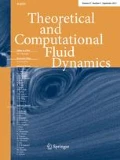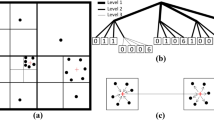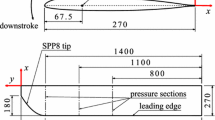Abstract
The numerical study of the wake of full-scale slender devices such as aircraft wings and wind turbine blades requires high-fidelity large eddy simulation tools. The broad spectrum of scales involved entails the use of coarse-grain models for the devices. Actuator disk or line methods have been developed for that purpose, and are to date the most employed in that context. These methods transfer the force from the device to the fluid using 3D mollification functions. A novel immersed lifting and dragging line method is here presented, together with its implementation in a hybrid vortex particle-mesh flow solver. The line models the effect of blades or wings on the flow through the generation of vorticity, in a Lagrangian manner. This has several advantages over the treatment inherent to actuator methods: The absence of mollification in the spanwise direction and the relaxation of the classical Courant–Friedrichs–Lewy condition contribute to keeping the accuracy and the efficiency at a high level. The method is thoroughly verified against theory using results on various airfoils and wings. Finally, the efficiency of the approach is illustrated with the simulation of the wake of an elliptical wing. The role of parasitic drag in the development of wake instabilities is pointed out, by comparing configurations with none, moderate and high profile drag. In the last case, the simulation captures the fine scales vortex dynamics and the establishment of a turbulent wake over a length of 30 wing spans.















Similar content being viewed by others
References
Breton, S.P., Sumner, J., Sørensen, J.N., Hansen, K.S., Sarmast, S., Ivanell, S.: A survey of modelling methods for high-fidelity wind farm simulations using large eddy simulation. Phil. Trans. R. Soc. A 375(2091), 20160097 (2017)
Caprace, D.G., Buffin, S., Duponcheel, M., Chatelain, P., Winckelmans, G.: Large eddy simulation of advancing rotor for near to far wake assessment. In: 43rd European rotorcraft forum. Milan, Italy, p. 570 (2017)
Caprace, D.G., Chatelain, P., Winckelmans, G.: Lifting line with various mollifications: theory and application to an elliptical wing. AIAA J. 57(1), 1–12 (2019)
Chatelain, P., Backaert, S., Winckelmans, G., Kern, S.: Large eddy simulation of wind turbine wakes. In: Rodi, W., (ed.) Proceedings of The 9th International Symposium on Engineering Turbulence Modelling and Measurements (ETMM-9), June 6–8, 2012, Thessaloniki, Greece, Flow, Turbulence and Combustion, vol. 91, pp. 587–605. ERCOFTAC, Springer (2013). https://doi.org/10.1007/s10494-013-9474-8
Chatelain, P., Curioni, A., Bergdorf, M., Rossinelli, D., Andreoni, W., Koumoutsakos, P.: Billion vortex particle direct numerical simulations of aircraft wakes. Comput. Methods Appl. Mech. Eng. 197(13), 1296–1304 (2008). https://doi.org/10.1016/j.cma.2007.11.016
Chatelain, P., Duponcheel, M., Caprace, D.G., Marichal, Y., Winckelmans, G.: Vortex particle-mesh simulations of vertical axis wind turbine flows: from the airfoil performance to the very far wake. Wind Energy Sci. 2(1), 317 (2017). https://doi.org/10.5194/wes-2-317-2017
Chatelain, P., Duponcheel, M., Zeoli, S., Buffin, S., Caprace, D.G., Winckelmans, G., Bricteux, L.: Investigation of the effect of inflow turbulence on vertical axis wind turbine wakes. J. Phys. Conf. Ser. 854(1), 012011 (2017). https://doi.org/10.1088/1742-6596/854/1/012011
Chatelain, P., Koumoutsakos, P.: A Fourier-based elliptic solver for vortical flows with periodic and unbounded directions. J. Comput. Phys. 229(7), 2425–2431 (2010)
Churchfield, M.J., Schreck, S., Martinez-Tossas, L.A., Meneveau, C., Spalart, P.R.: An advanced actuator line method for wind energy applications and beyond. In: 35th Wind Energy Symposium, p. 1998 (2017)
Cocle, R., Bricteux, L., Winckelmans, G.: Scale dependence and asymptotic very high Reynolds number spectral behavior of multiscale subgrid models. Phys. Fluids 21(8), 085101 (2009). https://doi.org/10.1063/1.3194302
Cocle, R., Winckelmans, G., Daeninck, G.: Combining the vortex-in-cell and parallel fast multipole methods for efficient domain decomposition simulations. J. Comput. Phys. 227(21), 9091–9120 (2008). https://doi.org/10.1016/j.jcp.2007.10.010
Cottet, G.H., Koumoutsakos, P.: Vortex Methods, Theory and Practice. Cambridge University Press, Cambridge (2000)
Dag, K.: Combined pseudo-spectral/actuator line model for wind turbine applications. Ph.D. thesis, Technical University of Denmark (2017)
Hallock, J.N., Holzäpfel, F.: A review of recent wake vortex research for increasing airport capacity. Prog. Aerosp. Sci. 98, 27–36 (2018). https://doi.org/10.1016/j.paerosci.2018.03.003
Hejlesen, M., Rasmussen, J., Chatelain, P., Walther, J.: A high order solver for the unbounded Poisson equation. J. Comput. Phys. 252, 458–467 (2013). https://doi.org/10.1016/j.jcp.2013.05.050
Hejlesen, M.M., Winckelmans, G., Walther, J.H.: Non-singular green’s functions for the unbounded poisson equation in one, two and three dimensions. Appl. Math. Lett. 89, 28–34 (2019). https://doi.org/10.1016/j.aml.2018.09.012
Hockney, R., Eastwood, J.: Computer Simulation Using Particles. Taylor & Francis, Inc., Bristol (1988)
Ivanell, S., Sorensen, J.N., Mikkelsen, R., Henningson, D.: Analysis of numerically generated wake structures. Wind Energy 12(1), 63–80 (2009). https://doi.org/10.1002/we.285
Jeanmart, H., Winckelmans, G.: Investigation of eddy-viscosity models modified using discrete filters: a simplified regularized variational multiscale model and an enhanced field model. Phys. Fluids 19(5), 055110 (2007). https://doi.org/10.1063/1.2728935
Jha, P.K., Churchfield, M.J., Moriarty, P.J., Schmitz, S.: Guidelines for volume force distributions within actuator line modeling of wind turbines on large-eddy simulation-type grids. J. Sol. Energy Eng. 136(3), 031003–031003 (2014)
Jha, P.K., Schmitz, S.: Actuator curve embedding—an advanced actuator line model. J. Fluid Mech. (2018). https://doi.org/10.1017/jfm.2017.793
Katz, J., Plotkin, A.: Low-Speed Aerodynamics, vol. 13. Cambridge University Press, Cambridge (2001)
Koumoutsakos, P.: Inviscid axisymmetrization of an elliptical vortex. J. Comput. Phys. 138(2), 821–857 (1997). https://doi.org/10.1006/jcph.1997.5749
Lee, S.J.: Numerical Simulation of Vortex-Dominated Flows Using the Penalized VIC Method, pp. 151–182. InTech, London (2017)
Martínez-Tossas, L., Churchfield, M., Meneveau, C.: Optimal smoothing length scale for actuator line models of wind turbine blades based on Gaussian body force distribution. Wind Energy 20, 1083–1096 (2017)
Martínez-Tossas, L.A., Meneveau, C.: Filtered lifting line theory and application to the actuator line model. J. Fluid Mech. 863, 269–292 (2019). https://doi.org/10.1017/jfm.2018.994
Meyer Forsting, A.R., Pirrung, G.R., Ramos-García, N.: A vortex-based tip/smearing correction for the actuator line. Wind Energy Sci. (2019). https://doi.org/10.5194/wes-2018-76
Mimeau, C., Cottet, G.H., Mortazavi, I.: Direct numerical simulations of three-dimensional flows past obstacles with a vortex penalization method. Comput. Fluids 136, 331–347 (2016). https://doi.org/10.1016/j.compfluid.2016.06.020
Moens, M., Duponcheel, M., Winckelmans, G., Chatelain, P.: An actuator disk method with tip-loss correction based on local effective upstream velocities. Wind Energy 21(9), 766–782 (2018)
Monaghan, J.: Extrapolating B splines for interpolation. J. Comput. Phys. 60(2), 253–262 (1985). https://doi.org/10.1016/0021-9991(85)90006-3
Noca, F., Shiels, D., Jeon, D.: A comparison of methods for evaluating time-dependent fluid dynamic forces on bodies, using only velocity fields and their derivatives. J. Fluids Struct. 13(5), 551–578 (1999)
Phillips, W., Snyder, D.: Modern adaptation of Prandtl’s classic lifting-line theory. J. Aircr. 37(4), 662–670 (2000)
Ploumhans, P., Winckelmans, G.S.: Vortex methods for high-resolution simulations of viscous flow past bluff bodies of general geometry. J. Comput. Phys. 165(2), 354–406 (2000)
Prandtl, L.: Tragflügeltheorie, pp. 451–477. Göttinger Nachrichten, Mathematisch- Physikalische Klasse, Berlin (1918)
Rasmussen, J.T., Cottet, G.H., Walther, J.H.: A multiresolution remeshed vortex-in-cell algorithm using patches. J. Comput. Phys. 230, 6742–6755 (2011)
Sbalzarini, I.F., Walther, J.H., Polasek, B., Chatelain, P., Bergdorf, M., Hieber, S.E., Kotsalis, E.M., Koumoutsakos, P.: A Software Framework for the Portable Parallelization of Particle-Mesh Simulations. Springer, Berlin (2006)
Scheurich, F.: Modelling the aerodynamics of vertical-axis wind turbines. Ph.D. thesis, University of Glasgow (2011)
Shives, M., Crawford, C.: Mesh and load distribution requirements for actuator line CFD simulations. Wind Energy 16(8), 1183–1196 (2013)
Sorensen, J.N., Shen, W.Z.: Numerical modeling of wind turbine wakes. J. Fluids Eng. Trans. ASME 124(2), 393–399 (2002). https://doi.org/10.1115/1.1471361
Spalart, P.R.: On the far wake and induced drag of aircraft. J. Fluid Mech. 603, 413–430 (2008). https://doi.org/10.1017/S0022112008001146
Spietz, H.J., Hejlesen, M.M., Walther, J.H.: A regularization method for solving the poisson equation for mixed unbounded-periodic domains. J. Comput. Phys. 356, 439–447 (2018). https://doi.org/10.1016/j.jcp.2017.12.018
Tollmien, W., Schlichting, H., Görtler, H.: Über Tragflügel kleinsten induzierten Widerstandes. In: Ludwig Prandtl Gesammelte Abhandlungen, pp. 556–561. Springer (1961)
Voutsinas, S.G.: Vortex methods in aeronautics: how to make things work. Int. J. Comput. Fluid Dyn. 20(1), 3–18 (2006). https://doi.org/10.1080/10618560600566059
van Rees, W.M., Leonard, A., Pullin, D.I., Koumoutsakos, P.: A comparison of vortex and pseudo-spectral methods for the simulation of periodic vortical flows at high Reynolds numbers. J. Comput. Phys. 230(8), 2794–2805 (2011)
Winckelmans, G.S.: Encyclopedia of Computational Mechanics. Vortex Method, pp. 129–153. Wiley, New York (2004). https://doi.org/10.1002/0470091355.ecm055
Acknowledgements
The development work benefited from the computational resources provided by the supercomputing facilities of the Université catholique de Louvain (CISM/UCL) and the Consortium des Équipements de Calcul Intensif en Fédération Wallonie Bruxelles (CÉCI) funded by the Fond de la Recherche Scientifique de Belgique (F.R.S.-FNRS) under Convention No. 2.5020.11. The production simulations used computational resources made available on the Tier-1 supercomputer of the Fédération Wallonie-Bruxelles, infrastructure funded by the Walloon Region under the Grant Agreement No. 1117545.
Funding
D.-G. Caprace is supported by Fonds De La Recherche Scientifique - FNRS (Grant NO. ASP6947).
Author information
Authors and Affiliations
Corresponding author
Additional information
Communicated by Jeff D. Eldredge.
Publisher's Note
Springer Nature remains neutral with regard to jurisdictional claims in published maps and institutional affiliations.
Appendices
Appendix A. Reconstruction of the effective upstream velocity
In the presence of parasitic drag, the effective upstream velocity \(\mathbf {U}_e\) differs from the measured \(\mathbf {U}_{0}\). We here obtain the velocity induced by the dragging vortex sheets, which will be used as a correction velocity \(U_\text {corr}\) to recover the effective upstream velocity in the ILDL model: \(U_e = U_\text {0}-U_\text {corr}\).
First, we consider a 2D steady, inviscid wake model with singular shed vortex sheets (Fig. 16) and an upstream velocity \(U_e\). With small drag forces such as those experienced on airfoils, we reasonably assume that these vortex sheets remain parallel. Using the Biot–Savart law, the velocity evaluated at the center O of the dipole is
Using this expression to substitute \(\mu \) in Eq. (10), we obtain
which provides the velocity correction factor
The factor \(C_d \frac{c}{d}\) plays an important role in this expression, and it is clear that it should be maintained well below unity for the correction to be valid.
In the ILDL, the vortex sheets are regularized using a 1D Gaussian regularization (of parameter \(\sigma _d\)) along y. The drag-induced mollified vorticity field is
where H(x) is the Heavyside step function. As \(\frac{\partial V_\sigma }{\partial x}\) is small, we obtain the horizontal velocity at \(x=0\) as
In case of pointwise velocity sampling, the correction \(U_\text {corr}\) is based on the evaluation of \(U_\sigma ^d\) at \(y=0\), and
and we obtain, again using Eq. (10),
This is consistent with Eq. (19) when \(\sigma _d \rightarrow 0\). We also make sure, in our simulations, that \(C_d \frac{c}{d}\) is well below unity.
In the present work, we use the “integral velocity sampling” [3], i.e., the principal value obtained as \(U_0 = \int \xi _{\sigma _l}(\mathbf {x}) U(\mathbf {x}) d\mathbf {x}\), where \(\xi _{\sigma _l}\) is the kernel used for the mollification of the bound vorticity, \(\xi _{\sigma _l}(y)= \frac{1}{\sqrt{\pi }} \frac{1}{\sigma _l} \exp \left( {-\frac{y^2}{\sigma _l^2}}\right) \). Therefore, \(U_\sigma ^d\) is used to derive an integrated correction,
In practice, this integral is evaluated numerically using the weights \(w_j\) of Table 1, where U is the velocity measured at the location of the bound vortex particles.
In general, \(\mathbf {U}_0\) is not aligned with \(\mathbf {U}_e\); the correction velocity should be aligned with the local shedding direction as shown in Fig. 2, and we use Eq. (24) in its vector form.
Appendix B. Errors related to the ILDL model assumptions
1.1 B.1 Error in drag evaluation, due to wake expansion
The expansion of the wake is neglected in the derivation of Eq. (8). This assumption generates a small error which can be quantified using Eq. (13).
Again, we use our simplified drag model made of two parallel singular vortex sheets (Fig. 16). As the vortex sheets are horizontal, the vertical velocity V across them is nonzero. Consequently, there is a contribution to drag from the integral of \(\mathbf {U}\wedge \varvec{\omega }\). This contribution can be assimilated to the error introduced by neglecting the expansion of the wake.
The vertical velocity induced by the two vortex sheets is
The model error in drag thus amounts to
This term is proportional to the square of \(\mu \), and it is therefore indeed negligible for small drags.
1.2 Drag-induced lift
In the ILDL model, it is implicitly assumed that the effects of lift and drag can be added by linear superposition. In fact, even with wake expansion neglected, an interaction exists, which can be quantified again using the simple model of Fig. 16, to which we add a singular bound vortex of circulation \(\varGamma \) at O (similar to what is presented in Fig. 2a).
As can be seen from Eq. (13), the integral of \(\mathbf {U}\wedge \varvec{\omega }\) will have a nonzero contribution from the combination of the axial velocity induced by the bound vortex and the circulation of the vortex sheets. The horizontal velocity induced by the bound vortex is
The interaction results in the appearance of some lift induced by drag,
When the mollification of the bound vortex and of the shed vortex sheets is taken into account, one can show that only a fraction of this term contributes to the drag-induced lift. The fraction depends on the values of \(\frac{\sigma _l}{d}\) and \(\frac{\sigma _d}{d}\), and it can be obtained numerically using the weights \(w_i\).
The drag-induced lift, as computed here, could thus be accounted for in the ILDL model by modifying Eq. (7). However, in this work, it was decided to keep the model in its simplest form. The error associated with this simplification is quantified in the analysis of the validation results.
Appendix C. Fourier-based Poisson solver for domains with unbounded and inflow/outflow directions
In this work, we rely on the Fourier-based solvers used by [5, 8] in order to solve Eq. (2) for the velocity. This solver handles a combination of periodic and unbounded directions through a Hockney–Eastwood approach [17] . We here extend that work to handle the unbounded directions together with the inflow and outflow conditions in the flow stream direction. Following [8], we re-write Eq. (2) as
where x is assumed to be the inflow/outflow direction and \(\nabla ^2_{yz}\) is the Laplacian operator restricted to the \(y-z\) plane. The Fourier-transform along x yields
where \(\tilde{\mathbf {u}}(k_x,y,z)\) stands for the x-transformed field. For a given \(k_x\) mode, this is a two-dimensional Helmholtz equation in an unbounded (y, z)-domain, which we can solve through the convolution with the Green’s function
where \(K_0\) denotes the modified Bessel function of the second kind. These expressions are singular at \((y,z)=(0,0)\). This is here circumvented by replacing them with the corresponding cell-averaged value [8], but we could alternatively use a mollified Helmholtz kernel [15, 16, 41]. The convolution itself can be carried out in Fourier space through the domain-doubling approach of [17].
In such a context, the imposition of inflow/outflow conditions simply corresponds to a restriction of the Fourier modes to be considered, depending on the symmetry conditions that need to be enforced on each side of the domain. We assume the domain to go from 0 to \(L_x\) in x. Considering the velocity field, we wish to impose the following conditions on the streamwise velocity: \(u_x(0,y,z) = u_x(L_x,y,z) = U_\infty \). This corresponds to odd symmetry conditions on \(\mathbf {u}_{\varvec{\omega }}\) at the inflow and at the outflow. These are completed with even symmetry conditions on the transverse components \(\frac{\partial u_y}{\partial x} (0,y,z) = \frac{\partial u_z}{\partial x} (0,y,z) = 0\) and \(\frac{\partial u_y}{\partial x} (L_x,y,z) = \frac{\partial u_z}{\partial x} (L_x,y,z) = 0\). The allowed modes thus have to be harmonics of a base mode of period \(2L_x\) with the proper phase
The modes of the corresponding vorticity field are then
Notice that, in general, any combination of symmetry conditions is accessible and it leads to domains with a periodicity of either 2 or 4 times \(L_x\).
The practical implementation of this restriction is made straightforward through the use of discrete sine and cosine transforms (DCT and DST) in our FFT-based solver. Advantageously, and unlike the domain-doubling technique for the unbounded directions, this implementation does not lead to a twofold (or fourfold) increase in the unknowns as the DCT/DST transforms are performed in the domain with its original \(L_x\) size.
Rights and permissions
About this article
Cite this article
Caprace, DG., Winckelmans, G. & Chatelain, P. An immersed lifting and dragging line model for the vortex particle-mesh method . Theor. Comput. Fluid Dyn. 34, 21–48 (2020). https://doi.org/10.1007/s00162-019-00510-1
Received:
Accepted:
Published:
Issue Date:
DOI: https://doi.org/10.1007/s00162-019-00510-1





